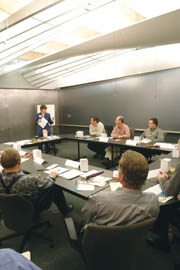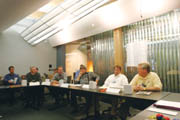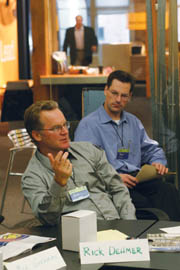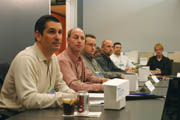
"The reason we're here is because I guess WE like what we do."
This was one of the very interesting things said at the recent contractor roundtable that W&C and USG hosted for a group of ceiling contractors from central and eastern sectors of the country. Overall, it was very positive. These are all very successful contractors who share many common concerns.
The hope is that readers can feel they were present at the roundtable and are invited to address any of their own concerns by writing to the magazine. The topics discussed-the past, present and future-provide some interesting insights into where the ceiling contractor fits into the vast sea that is construction.
The 10 contractors who participated were William Harnish, of Harnish Acoustical Inc., Redford, Mich.; Jeff Wilke, of Wilko Construction, Grain Valley, Mo.; Cyd Geary, of King Company, New Orleans; Lynn Moore, of Acoustic Ceilings Inc., Newport News, Va.; Bill Sherman, of JV Sgroi Inc., Syracuse, N.Y.; Tom Jacobson, of Jacobson & Co. Inc., Elizabeth, N.J.; Ray Verner, of Acousti Engineering Co. of Florida, Orlando, Fla.; Rick Dehmer, of Acoustics Associates, Minneapolis; Mike Farmer, of Precision Walls Inc., Raleigh, N.C.; and John Garcea, of RG Construction Services, Elmhurst, Ill.

Who we were
The first question moderator Brenda Rinholm put to the contractors was, "What has changed in the market in the last five to 10 years?"The answers were varied but not too surprising.
"There definitely seems to be more of a demand for higher-end ceiling products and specialty products. And the mold issue is also a factor now."
Other answers were that building codes have changed, including more seismic applications with ceiling tiles. One contractor mentioned that the service of the suppliers makes a big difference.
"We buy materials from suppliers in person so they have become more conscientious about servicing you and taking care of you, trying to get your business."
Another change in recent years has been the availability of more diverse product lines. The contractors pointed out that Curvatura, Compasso, 9/16-inch grid, slotted grid are all factors that weren't prominent 10 years ago when it was basically a "flat tile market." Also, there is far more variety in tile designs and patterns.
In addition to products, distribution, mold and code changes, the nature of doing business has also seen some change.
"We've had a couple of contractors start businesses under the sponsorship of general contractors, where a couple of guys will break off and the GC will basically feed them all their work and support them on getting started. I'm not sure what that's saying about the marketplace because we definitely have enough manpower and enough companies are out there. It might be a contractor thinking that there's a better way to control some of their costs and if he's thinking that, I would assume he's going to do that with other subs but I haven't seen that happen."
"We're seeing that in our area, too. A lot of the GCs are starting to do their own drywall work, their own acoustic work. In most cases, it's them employing a sub that gets halfway through a job and goes out of business on them, and then they hire their men and all of a sudden, the GC is now a drywall contractor and an acoustical contractor."
Not only are GCs cutting into some of the contractors' business but many of these subs are finding that they must offer the gamut of services to be considered on a project.
"Many construction companies are becoming a combined package, where a company is doing the drywall, the ceilings, the millwork, everything is under one contractor and the owner wants it that way because then he can control it."
Another topic regarding changes was contracts. The contracts from GCs shift more of the risk to the subs and there's a proliferation of OSHA insurance programs that further dig into profits."
The demands regarding getting a job done also have continued to tighten.
"Scheduling seems to decrease our allotted time more and more. You used to have four months to do something, now it has to be done in three. They expect you to do more in less time, which just crams all the trades into the same area at the same time, which is costly to everybody. We're in situations where they put the carpets down before they put the ceilings up."

Seems like mold times
The topic of scheduling segued right into the ever-popular topic of mold because some of the mold problems are the result of unrealistic scheduling, according to the contractors."If they would put the roof on and seal it before wall cavities get closed in, there would never be a mold issue."
But what is the reality of the mold situation? Is there really dangerous mold out there or is it almost an urban legend perpetuated by the legal system?
"Yes," "absolutely," and "that aggravates the problem," were three of the responses. Many markets are simply playing it safe, such as schools that are tearing out carpeting because carpet backing helps mold growth, and installing vinyl or linoleum. Many of the owners are indeed taking control of the situation by being proactive in addressing it.
"Mold is going to grow where you have water accumulation so that's what you have to control in a building. They're starting to build this into the contracts, saying that we have to remove X square feet of mold in X amount of time."
"I think it's a whole combination, that many people are jumping on the bandwagon for no real reason, schools particularly, because they can. I think there are real mold issues but only in specific places not throughout whole buildings."
"Nobody-not even us-wants to take the responsibility for mold. We don't want to be the ones liable because the school's got mold everywhere, neither does the architect or the owner, nor does the manufacturer."
Also, construction practices themselves may contribute to mold. Buildings are closed in better and don't breathe the way they used to. Everyone agreed that there was a healthy dose of sensationalism, comparing it to the asbestos issues of the past.
"When I first heard of mold on the ceiling tile, I thought it was a marketing concept because I've never really seen mold on the ceiling tiles unless it's in a warehouse that's been soaked for years or there's a roof leak. I never really considered it an issue."
One contractor's insurance company made his workers take a mold-training course from a certified environmental company. Not only is there liability in mold if the contractor is part of the new construction team, but there could be a bigger liability if a contractor goes into an existing construction and disturbs the mold. The message was to not get involved in remediation unless certified with the proper equipment and clothing, and knowing the specific regulations.
The future of things
Having discussed trends of the past, the contractors were then asked to pull out a "crystal ball" and look forward to what they can expect of their marketplace's demands. One contractor mentioned that he'd heard there will be ceiling products that have carbon compounds embedded in them to increase the reception of cell phones or computers. Another felt that there would be more open bar joists and less acoustical ceilings. Internally, one felt that better communication would become more common, with more workers having communication devices.Labor remains a sensitive issue.
"Workers get away with more than they should because they know contractors are desperate for workers. Also, the future is very uncertain as it appears that there is nobody new out there to train because nobody seems to want to get into the trade anymore."
One contractor got philosophical in his observation:
"Every great democracy, when it reaches its peak, the group that brought it to its peak gets lazy and only wants to live the high life, and you bring in immigrants or historically, even slaves, to do the work. We're seeing this happen now. It happened back when there were large German and Italian migrations back a ways and right now, you're seeing the Hispanic influx."
On the subject of what the coming trends will be on the material end, designers are creating more sophisticated buildings, which will result in a lot more specialties. Even the schools are doing high-end work. But the bottom line is specialties, more metal ceilings, will be the result of architects creating these looks for their clients "to make them look good."

Profitability
With all these successful contractors in one place, it had to be asked what the factors were that make their best projects profitable."It's mostly luck because it's all based on price. If the job goes better than it's supposed to, that's luck and that's often the difference between bigger profits."
"A good GC who is able to afford your price and schedule properly is the key to profitability on most jobs as far as I'm concerned. If you get in at the right time without a lot of other trades being in your way, I think that leads to why most of our jobs are profitable. The better the GC, the better the profitability."
One contractor felt that his company's expertise at doing more complex projects allowed him to bid lower than other companies with less experience that were fearful it would take more time and bid accordingly. Bidding is an art form, it seems. A contractor must be able to guess what his competition will bid vs. what he should bid to not only get the job but also ensure its profitability. Contractors must be bold enough to ask for enough money and set their prices to expect a profit.
The crew assigned to a project is also crucial to profits.
"If you can put your best men, your best project managers on it, you'll be more efficient. For us, it's putting the best people where most appropriate and being organized."
Another way to help profits is to simplify when possible, find ways to still give the owner what he wants but in ways that might cost less. Materials can also make a job more or less profitable.
"The most profitable job we did in the last year was a terminal where the subway comes out of the ground, requiring a metal ceiling. We furnished no material, just labor."
Finally, another contractor says his most profitable jobs are usually the ones that no one else wants to bid.
"It's the three Ds: Dirty, dangerous or difficult means less competition for getting the job."
So, what else bites into profits? Bad GCs with poor scheduling, leaving out some of the information in an estimate, bad drawings, jobs running beyond the scheduled completion, even security are all factors that can cut into profits.
Productivity
Asked if anything had caused a quantum leap forward in productivity, the answers included, platform scaffold, snap grid versus hook grid, 2x4 tiles to simulate 2x2 tiles, non-directional tiles and patterns that don't require installers to think about which way the patterns face.The best tool appears to be a good foreman: "If you have a good foreman to keep on top of your men, stay on top of them and monitor production to make sure you get the most out of them, this matters a lot more than convenience in products or tools."
Good foremen need good crews. The contractors agreed that one must keep the good workers and bring them along in your system, let them get to know the other guys and teach them all how to work together, keeping them working and productive. Training can help but one contractor felt that once you train someone, he'll go somewhere else and make $2 more per hour. Training alone can't necessarily create a good technician.
"It's like looking at Michael Jordan, no matter how hard anyone works or trains, he doesn't have Jordan's talent. So, what you need are the right people for the right jobs. If they like the work and are good with their hands, these are the guys that will make you money. There are guys you can put on a job no matter how difficult and they will always make you money and maximize the job. Then there are guys who are sort of middle-of-the-road, they have their ups and downs, and finally, the guys that do one or two jobs and they're gone."
Wish list
When asked what they'd wish for to help their businesses, the contractors had answers that covered the industry quite thoroughly: 20 great foremen, 20 great installers, 20 great customers and less competition. It soon became apparent that there was an ugly truth lurking beneath the surface of everyone's answers: that these contractors lacked much of the control of their own destinies. They cannot control pricing, prompt payment, higher profit margins, more work and less competition. In other words, luck does indeed seem to play a large part in success, at least according to this group. And yet, there are some things contractors can control, such as whom they choose to work for. And the very success these contractors have achieved suggests that they have found ways to control their destinies in ways that result in success."We're doing work in our area with the people we want to work with and not doing work with people we don't want to work with."
"You've always got to be looking for new customers and good people to work for. We'll find a new customer and we'll do the job, and we'll see how they treat us during the course of that job, and if they didn't treat us right and we don't think we can make money with them, we knock them off the list and look elsewhere."
"We don't have a lot of control but we are trying to get better installers, better foremen, we're trying to do more work at higher margins."
"Our competitors control our prices. We can only control our costs."
One of the final topics was put to the roundtable by USG. W&C's interest in the roundtable is to glean topics for future articles, to ascertain what are the hot topics on which readers need the most information. USG, as a manufacturer, gets the chance to talk directly to its target market. Do new and better products help contractors increase profits? Are the manufacturers addressing the needs of contractors?
The responses were that all the contractors' competitors were doing the same thing, therefore, any new product or better tool, is available to the competition, which keeps the playing field frustratingly level.
"If you make something easier and more efficient, you're going to get an advantage for about a year and then someone's going to catch up and do it as well. You do get a first mover advantage for a period of time but you have a finite window in which to capitalize on it before someone else catches up."
"New products and tools may save us 20 percent in labor but it's also saving every trunk slammer the same thing."
"In the 1960s, another manufacturer came out with a system that was a proprietary product. This manufacturer would take certain contractors who committed to the product, to its integrated system nature. Those are the kinds of things contractors are desperately needing in the marketplace, especially for this group here trying to be independent contractors and not live by distributors and so forth."

Report Abusive Comment